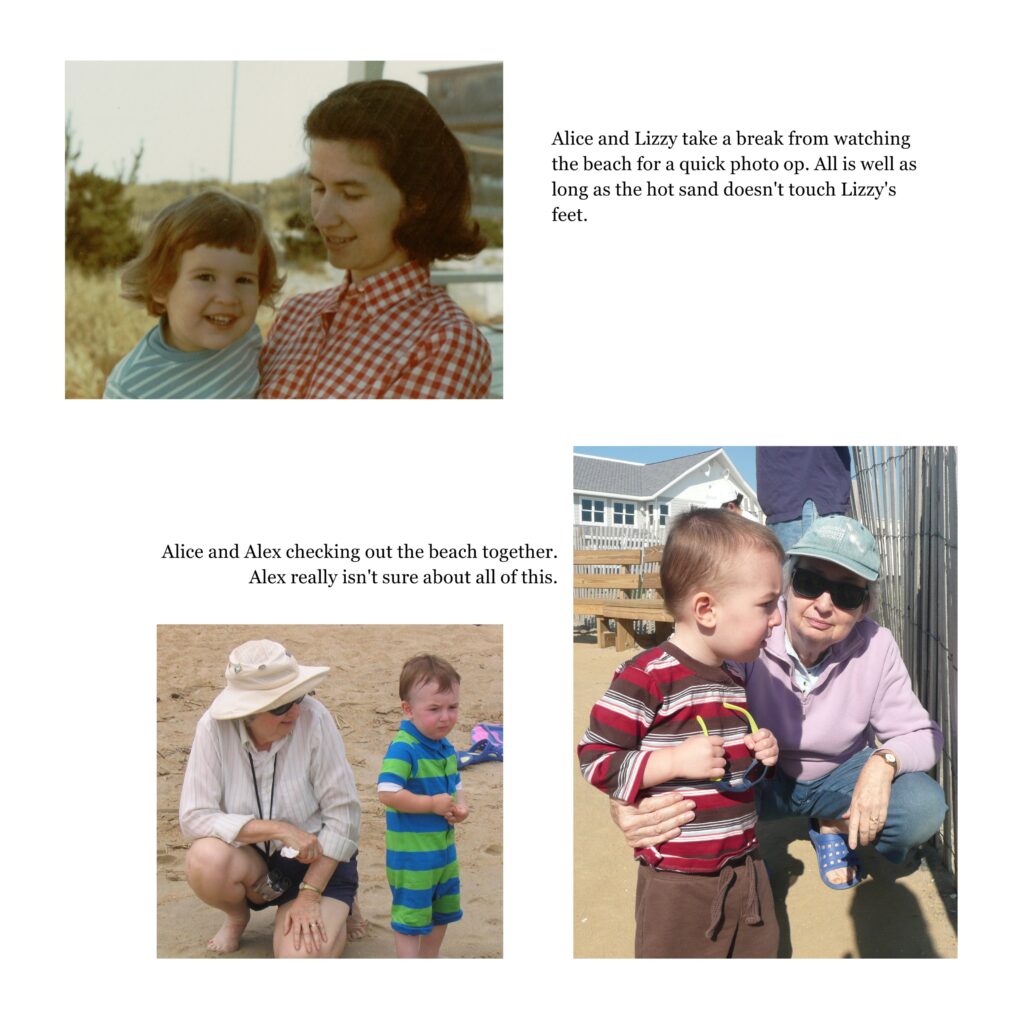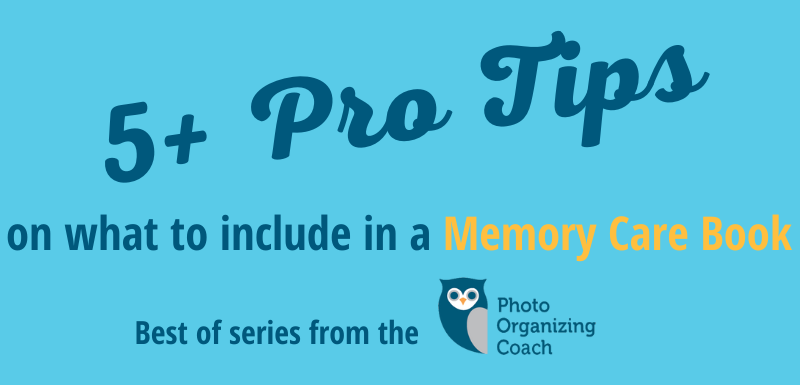This article was one of the most popular from the old Baltimore Photo Solutions blog. Kathy continues to speak with people and groups about the whys and hows of special photo books for people with dementia. Here are five tips from a professional photo organizer and health care professional, with personal experience making these books for family, friends and clients.
What is a Memory Care Book?
Quite simply, a “memory care book” is a term I came up with years ago to describe a specific kind of photo book that is created especially for someone who is living with dementia. There may or may not be other health considerations (such as hand tremors or eyesight issues) that need to be considered in designing the book.
These photo books can be used as a therapeutic tool to stimulate memories, or they can be used by family and friends who aren’t sure what to say when they visit. I’ve also heard of skilled nursing staff and hospice volunteers using them with patients, having specific conversations to engage on a deeper, more personal level.
Keep it simple
A Memory Care book can be anything you want or need it to be. The most important points are that it should be SIMPLE, soothing, and useful. It should be easy to read. It should also be OK to be handled, not tucked away as something too precious to touch. In my experience with memory care units in skilled nursing facilities, items can wander, get spilled on, and more.
What to include?
Beyond the basic rule of keeping the design, layout and content SIMPLE, the issue I see most people struggling with when creating a Memory Care book is how to include everything in the book. In short, you can’t.
It can be very hard for individuals with dementia to focus for long periods of time. Brains and eye fatigue is a frequent concern with this population. So, keep the content of the book very limited. This is not a biography, and it shouldn’t include all of the most important photos from someone’s life. Pick a narrow theme, such as someone’s favorite hobby or vacation spot. Or a small story to share. You can always do another book.
How to select photos for your Memory Care book
Photo quality is important. Blurry photos can be even harder to appreciate for someone with vision problems. Dark or faded images can also be frustrating.
These guidelines can help people winnow down a huge collection of photos into a manageable amount (~25-30) for a Memory Care book.
Here are five of my favorite tips for what to include in a Memory Care book. I hope that you can learn from my successes (& failures) over the years in making these books, and teaching others how to make them for both loved ones and clients.
1. Start with a smile
Find a favorite picture that shows the subject smiling. I begin every Memory Care book with a close up of the recipient of the book. It doesn’t need to be a recent photo.
In this sample book, Jack is smiling, clearly having fun swimming. The first page is a solo shot of Jack in action.

2. Keep it positive
Think about what defines them as a person. Focus on the happy things. It could be a hobby, a favorite place, or a special family event or tradition. In this sample book, Jack was a master swimmer for many years. Telling stories about Jack swimming (in the pool at his retirement community) and teaching his grandchildren to swim is a great subject.
3. Don’t include known triggers
Sometimes people with dementia can be upset by certain memories. It’s important to keep the focus on positive subjects, and avoid anything that is likely to cause a negative reaction. And sometimes, a book has to be put away for a while until the association or trigger goes away. In this sample book, Jack was an avid gardener for many years. His home had amazing gardens that he loved to maintain. But as his memory fades, Jack isn’t as clear about when they sold their house (almost a decade ago) and moved into their retirement community.
I didn’t want to include upsetting subjects, so I focused on his more recent gardening work, and their annual trip to Sherwood Gardens. We chose not to include any pictures in the book that might trigger the “where am I and when can I go home?” conversation.

4. Include special people, places or subjects
I like to include family in most Memory Care books. Even if it’s a book focused on someone’s love of classic cars, have photos of family members with the cars.
I don’t always have a chronological structure to my books. In this example, family beach vacations are the unifying theme. The subject of this book, Alice, is seen at the beach with two generations of children, her daughter and grandson. The captions continue the story of family beach vacations from the prior pages. The text is very clear about who is in each picture and when it was taken. We were careful not to go back and forth in time too often. (I should also mention that Alice had cataract surgery and could handle a smaller font in her book than what we needed to do for Jack.)

5. Minimal content per page
Only place a few photos per page. Three photos on the above sample page is a lot. I balanced that out with just one soothing photo on the facing page. Also notice that I cropped close to the people to direct the eye to the central subject.
Keep the design extremely simple and do not include any distracting elements. Make it easy on the eyes to stay on the pictures. Incorporate lots of negative (blank) space and big text in an easy font (I use Georgia a lot). I also increase line spacing a bit, and use shorter paragraphs to help eyes from getting lost in the text.

Learn more about making Memory Care books
I hope that these guidelines are helpful to you when creating a Memory Care book for your family, friend, or client.
When I give presentations about creating books for people with dementia, I go into these tips in much greater detail, and share other things I’ve learned along the way. I’m working on an online course about creating Memory Care books, let me know if you’re interested and what specific questions you want me to cover.

Leave a Reply